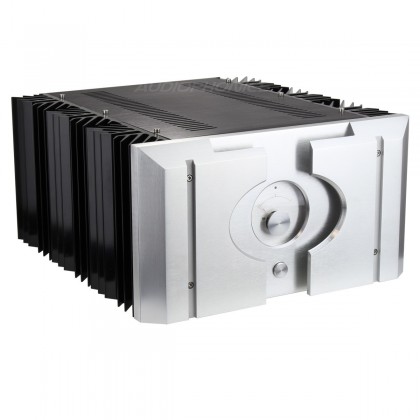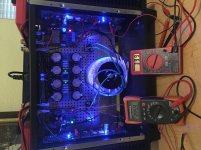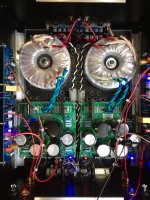For my winter project i'm planning to build an amplifier.
As pre i will use my Naim UnitiQute 2 (for now).
After a lot of reading i got my attention to the FirstWatt designs because my first requirements are - Pure Class A - Single Ended - Fets.
Finaly i think the Aleph-J will suits most of my requirements so i am planning to build one .. yeah!
I need a lot of reading as i see so many threads about this amp and the different 'settings'.
Planning is to build the Aleph-J according the following items:
- PCB v2
- BOM Rev. C for now .. i know there is a Rev. D but i need a lot of reading 🙂
- J74/J74 Stereo Differential Kit when available
- Aleph J Transistor Kit (i think the items are not complete .. zener?)
- Universal Power Supply
I hope these items and heat dissipation will fit into this chassis ?

To be continued ...
The Zener diodes in the store's transistor package kit that I received didn't match up with the published BoM in Post #1 that calls for a 9.1 V unit. Pretty easy / cheap to resolve. It's noted by others in the thread as a cautionary tale more than once ... somewhere.
There are a couple of items that you don't absolutely need in most cases. I ordered parts before I fully understood this. A second / third / fourth ... reading eventually got me sorted. A lot to read.
Are you serious about that chassis? Looks like a full on Pass unit. Care to share the source? I used the modushop/DIYAS 5U UMS unit and it's turned out fine. I opted for the front panel handles. I'd suggest that that is a worthwhile addition - the big fella certainly has some heft.
Enjoy the journey. Mine took a fair few months to get together. Life got in the way. Plus the inevitable bumps in the road had me travelling to my local electronics components store(s) for that one little part that got overlooked. Sourcing the P-channel JFETs also added to the timeline.
The chassis is huge. (Remember, Nelson says, "There's no such thing as heatsinks too big.") 
You should have zero issues making everything fit. 😀
.

You should have zero issues making everything fit. 😀
.
Hmmmm...
Assuming that the chassis is yet another Ebay special from China, one needs to be very careful about reading the dimensions. So far, all of the chassis of this look-alike design are considerably smaller in both heat sink area and internal volume compared to the Modushop Dissipante 4U, 400mm deep chassis available through the diyAudio store.
There are good, suitable chassis available, but these copycat N. Pass designs are overpriced for what they actually are.
Assuming that the chassis is yet another Ebay special from China, one needs to be very careful about reading the dimensions. So far, all of the chassis of this look-alike design are considerably smaller in both heat sink area and internal volume compared to the Modushop Dissipante 4U, 400mm deep chassis available through the diyAudio store.
There are good, suitable chassis available, but these copycat N. Pass designs are overpriced for what they actually are.
The Zener diodes in the store's transistor package kit that I received didn't match up with the published BoM in Post #1 that calls for a 9.1 V unit. Pretty easy / cheap to resolve. It's noted by others in the thread as a cautionary tale more than once ... somewhere.
There are a couple of items that you don't absolutely need in most cases. I ordered parts before I fully understood this. A second / third / fourth ... reading eventually got me sorted. A lot to read.
Are you serious about that chassis? Looks like a full on Pass unit. Care to share the source? I used the modushop/DIYAS 5U UMS unit and it's turned out fine. I opted for the front panel handles. I'd suggest that that is a worthwhile addition - the big fella certainly has some heft.
Enjoy the journey. Mine took a fair few months to get together. Life got in the way. Plus the inevitable bumps in the road had me travelling to my local electronics components store(s) for that one little part that got overlooked. Sourcing the P-channel JFETs also added to the timeline.
Thanks for the input !
The zener will be: BZX85B9V1-TR Vishay Semiconductors | Mouser Nederland
The chassis is huge. (Remember, Nelson says, "There's no such thing as heatsinks too big.")
You should have zero issues making everything fit. 😀.
The case actualy is a little version of the Pass: 396x360x195mm, internal: 240x360x188mm
Hope everything will fit ...
The PSU i think will not be the one from diyaudio but looks similar, 8x33mF with bleeder.
Could you tell me why there is 8x .47ohm resistors in the rail ?
Last edited:
It's from AudiophonicsHmmmm...
Assuming that the chassis is yet another Ebay special from China, one needs to be very careful about reading the dimensions. So far, all of the chassis of this look-alike design are considerably smaller in both heat sink area and internal volume compared to the Modushop Dissipante 4U, 400mm deep chassis available through the diyAudio store.
There are good, suitable chassis available, but these copycat N. Pass designs are overpriced for what they actually are.
100% Aluminium DIY Box / Case with Vu-meter for Audio Amplifier 396x360x195mm - Audiophonics
Don't know where from, but Audiophonics is a good supplier.
That is a taller chassis than the ones I have seen. The heatsink area is close to the one from Modushop, but the internal area is still a little smaller. If you want to use a dual-mono power supply (highly recommended), then some creativity will be needed to make everything fit inside.
I also suggest using power transformers with 19V or 20V secondaries in order to get the recommended +/- 24V supply to the amplifier boards. With the higher current draw of an Aleph J, you can only expect to get about 22.5V with 18V secondaries and conventional rectifier diodes.
I also suggest using power transformers with 19V or 20V secondaries in order to get the recommended +/- 24V supply to the amplifier boards. With the higher current draw of an Aleph J, you can only expect to get about 22.5V with 18V secondaries and conventional rectifier diodes.
Thanks i will keep that in mind !That is a taller chassis than the ones I have seen. The heatsink area is close to the one from Modushop, but the internal area is still a little smaller. If you want to use a dual-mono power supply (highly recommended), then some creativity will be needed to make everything fit inside.
I also suggest using power transformers with 19V or 20V secondaries in order to get the recommended +/- 24V supply to the amplifier boards. With the higher current draw of an Aleph J, you can only expect to get about 22.5V with 18V secondaries and conventional rectifier diodes.
So, I have an odd question.
I've gotten to nearly the end in my build and am on the last step of measuring the voltage drop accross R7.
Interestingly enough, changing R27 doesn't appear to have any effect on the voltage drop which is about .6V on both channels.
One mistake I did notice that I made was, I did not jumper R6, R30, J1, J2, instead I ordered the resistors for these locations from the BOM and stuffed them in there. I know, foolish mistake for not reading first.
I have tested voltages at each step throughout the build up to this point, so I know that my power supply is correct.
Does anyone have any ideas?
I've gotten to nearly the end in my build and am on the last step of measuring the voltage drop accross R7.
Interestingly enough, changing R27 doesn't appear to have any effect on the voltage drop which is about .6V on both channels.
One mistake I did notice that I made was, I did not jumper R6, R30, J1, J2, instead I ordered the resistors for these locations from the BOM and stuffed them in there. I know, foolish mistake for not reading first.
I have tested voltages at each step throughout the build up to this point, so I know that my power supply is correct.
Does anyone have any ideas?
What's in resistor location R27 (next to R24, between the 2 can caps)
Nothing. Did I miss something? 🙂
Yup. Jumper it. The pot will work then.
Also, are you able to adjust output offset with R7 pot? If yes, and you can get the offset to/near zero, it sounds like you are good to go.
Also, are you able to adjust output offset with R7 pot? If yes, and you can get the offset to/near zero, it sounds like you are good to go.
Yup. Jumper it. The pot will work then.
Doh.
If that was the only mistake I made on this build, I'll be a happy man. Thanks 6L6! I'll do just that and report back.
...and we have a new Aleph J in the world!
Well Done! Great amp.
Well Done! Great amp.
Thanks.
I’m really interested to hear where this design differs from the F5 I built years ago. Unfortunately, I don’t still have it here to compare.
Next up, I’m thinking about building a B1 with Korg triode. Does anyone know if it’s a good match to the Aleph J?
Most designs i see here use 1 transformer.If you want to use a dual-mono power supply (highly recommended) ... .
Does it makes realy a big difference when i used 2 transformers for each rail?
I was planning to use a single 800VA with 8x33mF and 1 bridgerectifier.
Pricewise it doesn't make a difference if i use 2x300VA/20V transformer and use 4x33mF on each side.
Last edited:
I could make use of a 90 degree mounting bracket so i can put the 2 transformers against each other.The heatsink area is close to the one from Modushop, but the internal area is still a little smaller. If you want to use a dual-mono power supply (highly recommended), then some creativity will be needed to make everything fit inside.
That would make a package of around 150mm width and 130mm height
And 1 transformer for the speaker protection module (12V)
I see i need to read the changes in jumper the following components: R6, R30, J1, J2.
This is for BOM rev C or ?
This is for BOM rev C or ?
Most amplifier builds shown here use a single power transformer because it is easier and less expensive than building a full dual-mono power supply. Not because a single transformer will perform or sound better. A properly built dual-mono amp is like having two completely separate amps inside a single chassis. Ideally, they should only share the input power cord and on/off switch. This way, there is no interaction between the two channels.
I built my M2x with a shared power supply, using a single 400VA transformer and four 22000 uF caps on each rail. It needed a little more work, including adding a set of motor run film capacitors which were wired directly to each channel's main board, before it sounded the way I wanted it to. When I built my Aleph J, I used a pair of 300VA transformers with 20V secondaries and a pair of CRCRC power supply boards from a group buy a while back. The Aleph J has sounded wonderful from the first day I played it in my system, and I haven't felt a need to change anything. That amp is shown in the picture below. In my opinion the Aleph J can easily be the last amp you will need to build, so it makes sense to take a little extra time with it.
I do not recommend adding a speaker protection module. This is an unnecessary complication and expense. The Aleph J has built-in current limiting which will help protect your speakers. Following a proper bias adjustment and burn-in procedure on your test bench of a couple hours, there is no need to worry about reliability.
I built my M2x with a shared power supply, using a single 400VA transformer and four 22000 uF caps on each rail. It needed a little more work, including adding a set of motor run film capacitors which were wired directly to each channel's main board, before it sounded the way I wanted it to. When I built my Aleph J, I used a pair of 300VA transformers with 20V secondaries and a pair of CRCRC power supply boards from a group buy a while back. The Aleph J has sounded wonderful from the first day I played it in my system, and I haven't felt a need to change anything. That amp is shown in the picture below. In my opinion the Aleph J can easily be the last amp you will need to build, so it makes sense to take a little extra time with it.
I do not recommend adding a speaker protection module. This is an unnecessary complication and expense. The Aleph J has built-in current limiting which will help protect your speakers. Following a proper bias adjustment and burn-in procedure on your test bench of a couple hours, there is no need to worry about reliability.
Attachments
Great looking !
Did the calculation this morning for a dual power rail, but compared to the 800VA vs 2x300VA makes no difference.
I was planning to use 8x33mF, so they can be used as 4 caps each rail needed only some extra R's and an bridgerectifier ... that won't make a huge difference of costs so i make a dual power supply for the Aleph.
But you say the only connection between the rails are the mains inlet, but what about the ground (0)?
Do you put secundairy ground (0) to earth or is it better to make secundairy float?
Did the calculation this morning for a dual power rail, but compared to the 800VA vs 2x300VA makes no difference.
I was planning to use 8x33mF, so they can be used as 4 caps each rail needed only some extra R's and an bridgerectifier ... that won't make a huge difference of costs so i make a dual power supply for the Aleph.
But you say the only connection between the rails are the mains inlet, but what about the ground (0)?
Do you put secundairy ground (0) to earth or is it better to make secundairy float?
- Home
- Amplifiers
- Pass Labs
- Aleph J illustrated build guide

